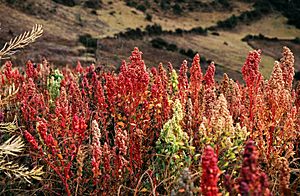Chiripa culture facts for kids

Map of Lake Titicaca
|
|
| Geographical range | Southern shore of Lake Titicaca |
|---|---|
| Period | Formative |
| Dates | 1400 BCE - 100 CE |
| Preceded by | Jisk'a Iru Muqu |
| Followed by | Tiwanaku |
The Chiripa culture was an ancient civilization. It existed from about 1400 to 850 BCE. They lived along the southern shore of Lake Titicaca in Bolivia. This time is known as the Initial Period or Early Horizon in the history of ancient Peru.
Chiripa Buildings
The main site of Chiripa has a large mound or platform. This platform was the most important part of their village. On top of it, there was a rectangular sunken plaza. In the middle of this plaza, there was a carved stone. This plaza was quite big, about 22 by 23.5 meters. People likely used this special public space for important ceremonies. These ceremonies helped show the power and importance of the leaders.
Around the sunken plaza, there were fourteen houses. These houses had thatched roofs, made from straw or reeds. They also had double walls built from cobble stones and adobe (a type of mud brick). These houses were arranged in a trapezoid shape. Inside, they had colorful wall paintings and yellow clay floors. Between the houses, there were special bins built into the walls. People believe these bins were used to store items for ceremonies.
It was not easy to get into the plaza or the houses. There were only two entrances to the whole complex, one on the north side and one on the south. Each house had a single stone door. The wall bins could be reached through a single, fancy window.
Archaeologists found burials inside the floors of some houses. Most of these burials were for children or babies. Their graves were often marked with stones. Adult burials were usually not marked. Many of the marked graves of children had valuable items. These included gold, copper, shells, and lapis lazuli (a blue stone). Only one marked adult grave had such goods. Adult bones were often found in bundles above ground in other parts of the site. The different ways people were buried and the items found with them might show that people had different social statuses.
Chiripa Through Time
During the Early Horizon period, Chiripa farmers grew small gardens. They harvested quinoa and other plants for food. Around 800 BCE, archaeologists found that almost all the plant remains at Chiripa's main center were quinoa. This suggests quinoa became very important.
The Taraco Archaeological Project (TAP) has been studying Chiripa since 1990. This project is led by Dr. Christine Hastorf from the University of California, Berkeley. They have divided the Chiripa culture into three main time periods:
- Early Chiripa (1500-1000 BCE)
- Middle Chiripa (1000-800 BCE)
- Late Chiripa (800 BCE-100 CE)
These periods are based on how their pottery looked, their buildings, and their farming methods.
During the Middle Chiripa phase, more people lived in the village. The village grew to about 4.25 hectares (about 10.5 acres). Archaeologists did not find many regular houses from this time. However, they found one of the earliest large public buildings in the Lake Titicaca area. This was a huanca, which is a semi-underground plaza or court. It was built around 1000 BCE. This structure was trapezoid-shaped and about two meters deep. It had a white-yellow clay floor and stone walls covered with yellow clay plaster.
In the Late Chiripa phase, the settlement grew even more, to 7.7 hectares (about 19 acres). The people built new, more complex public structures. Early in this phase, the "Choquehuanca" structure was no longer used. Instead, another sunken area called "Llusco" was built in the southern part of the site. Llusco was closed around 600 BCE. Then, people started building the most famous part of the site: a large platform mound called the Montículo. It was 50 by 50 meters (about 164 by 164 feet).
The Montículo was built in two main stages. From 600-400 BCE, people built rectangular "Lower Houses" around a small platform. Around 400 BCE, these Lower Houses were closed. Then, people started building the "Upper Houses." These were changed and used until about 100 CE. The final Montículo had a semi-underground court. It also had a ring of permanent adobe and rock buildings. The Montículo was a public space for ceremonies. People honored their ancestors there. Food was also served and possibly stored for community events.
Farming and Food
In the Early and Middle Chiripa periods, people mostly had small gardens. They grew both regular quinoa and a wild type called quinoa negra. Quinoa negra is like a weed that grows with domesticated quinoa.
Around 800 BCE, there was a big change. The number of quinoa negra seeds found dropped a lot compared to regular quinoa seeds. This means farmers started managing their crops differently. To reduce the wild quinoa, they might have created special fields. They also likely weeded more carefully and chose better seeds for planting. This change in farming happened at the same time as new ceremonies and political practices appeared at Chiripa. Finding large amounts of quinoa seeds at the Montículo suggests this food was very important for activities there.
Archaeologists also found early potatoes at Chiripa. These potatoes date back to between 800 and 500 BCE.
The Chiripa site was first described by Padre Pedro Marabini in the 20th century. Since 1990, the Taraco Archeological Project from the University of California, Berkeley has been doing research there. This research is led by Christine Hastorf.
See also
 In Spanish: Cultura chiripa para niños
In Spanish: Cultura chiripa para niños


